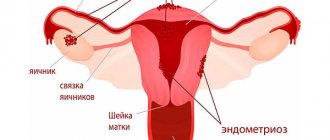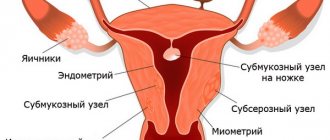Indications for surgery and methods of implementation
The main goal of surgical treatment is the complete elimination of pathogenic foci. Many experts believe that the best option is to perform an operation exclusively, since only this can remove all large foci of endometrial growth, followed by follow-up treatment with hormone therapy.
For different forms of the disease, indications for surgical intervention are:
- The appearance of an endometrioid cystic formation in the ovary;
- Retrocervical location of lesions;
- Lack of effectiveness when using conservative methods of care and severe pain;
- Combination of endometriosis and malignant tumor;
- Infertility due to disease;
- Absolute contraindications to the use of hormonal therapy;
- Extensive damage to internal organs;
- Constant bleeding with the threat of developing anemic syndrome.
Surgery is recommended for adenomyosis if fibroids develop against its background.
There are the following methods for removing endometriosis:
First.
Severe and persistent blood loss is treated with arterial embolization.
Second.
Neoplasms and cysts associated with the disease are eliminated by abdominal surgery for endometriosis.
Third.
Deep and extensive damage to the uterus leads to the need for extirpation, which is performed using the transvaginal method.
Fourth.
If it is necessary to obtain the maximum effect and at the same time leave the woman hope of becoming pregnant, the laparoscopic method is used.
Efficiency and fast recovery
During a woman’s childbearing age, the success of treatment is determined by the restoration or preservation of reproductive function. With the modern level of development of operative gynecology and the widespread use of gentle laparoscopic techniques, such results are achieved in most patients.
These are the successful operations for the surgical treatment of endometriosis that are carried out at the international medical center ON CLINIC
. Curettage for endometriosis can be performed there either on an outpatient basis or with hospitalization for 1-2 days. In any case, a few days after the operation, the woman can return to her usual rhythm of life.
For some patients, a successful procedure and subsequent rapid recovery may require treatment of concomitant diseases and proper preoperative preparation.
How is laparoscopy performed?
Removal of endometriosis during laparoscopy is carried out using highly sensitive equipment, which includes a viewing screen, sensors, a computer and manipulators. The laparoscope itself is a collection of several tubes connected to a video camera.
Several tiny holes are made in the skin of the abdomen through which endoscopic instruments are inserted. The operation is usually performed under general anesthesia. But in case of intolerance, local anesthesia or spinal anesthesia is sometimes used.
First, carbon dioxide is injected into the abdominal cavity to facilitate vision. Then, using a monitor, a careful examination and assessment of the condition is carried out, and then direct removal of pathological foci.
The time for laparoscopy for endometriosis ranges from 30 to 60 minutes.
If previously unknown areas of damage are discovered, the surgeon may need additional time.
Pathological growths are eliminated by two main methods - excision (using special scissors) and cauterization (laser or electricity). At the same time, a biopsy of the altered tissue is performed, followed by its examination for histology.
It is preferable to treat the disease with the help of such an intervention due to its minimal trauma and rapid recovery period. Recovery after laparoscopy, provided there are no complications, is quite quick.
After the operation, the woman spends 2-3 days in the hospital. After this, she is prescribed sexual abstinence, avoiding physical activity, and avoiding swimming in ponds and baths for two weeks or a month.
Pregnancy after laparoscopy for endometriosis should be planned within a few months. And if a woman’s infertility occurs due to this particular disease, usually everything goes well.
Laparoscopy performed for endometriosis of the uterus and other organs is also used as a diagnostic method. It allows you to fully assess the degree and depth of development of pathological changes.
Surgical Treatment Options
There are two methods for removing the uterus:
- Extirpation – removal of the entire organ;
- Supravaginal amputation - removal of the uterine body (the cervix remains).
It is also useful to read: Use of Buserelin Long (Depot) for endometriosis
With adenomyosis, the operation is often extended to the removal of the uterine appendages - the ovaries and fallopian tubes. According to indications, adhesions are excised, lesions on the peritoneum are removed, and intestinal resection is performed. This tactic is justified in cases of widespread endometriosis affecting many pelvic organs.
Types of surgical removal of the uterus.
Access options:
- Laparoscopic surgery. The doctor performs manipulations through small incisions. This operation requires high-precision equipment and specialists. The intervention is low-traumatic: it occurs with minimal damage to the pelvic organs. The risk of bleeding and adhesions is low. Recovery after surgery takes 3-4 weeks;
- Vaginal surgery. The doctor performs manipulations through the vagina using special equipment under laparoscopic control. This operation is also considered low-traumatic, but the risk of complications increases. The specificity of the access is such that the doctor cannot always quickly stop the bleeding and eliminate its consequences. Recovery after surgery occurs within 3-4 weeks;
- Laparotomy (abdominal surgery). The doctor makes an incision through which he performs all manipulations. This is a traumatic operation with a high risk of adhesions and significant blood loss. But during such an intervention, the doctor has more opportunities for various manipulations, and it is easier for him to cope with possible complications. Recovery is long and takes up to 6-8 weeks.
If technically possible, the uterus is removed during laparoscopy. This is the most comfortable and safe option for the patient. Abdominal surgery is indicated for concomitant large fibroids, pronounced adhesions, the presence of a suture on the skin of the abdomen and other conditions.
Laparotomy is indicated for concomitant diseases of the uterus and various types of complications, for example, for large myomatous nodes.
According to the compulsory medical insurance policy in public clinics, the operation is free of charge for the patient. But not every gynecological hospital has the opportunity to perform laparoscopy or vaginal hysterectomy. Often, you need to sign up for surgery in advance and wait in line for several months. Therefore, women often turn to private medical centers. The cost of the operation varies. Abdominal hysterectomy will cost 20-40 thousand rubles, laparoscopy or vaginal surgery - 50-100 thousand rubles.
Treatment after surgery
Despite the generally recognized high effectiveness of the operation, there is a possibility that the disease will develop again. In order to prevent relapse, it is necessary to continue treatment of endometriosis after laparoscopy.
Taking hormones.
It is especially important to carry out hormonal therapy for prevention. After the intervention, the patient receives a course of medications in the form of injections or tablets.
All options and selection of medications are carried out exclusively by a doctor, taking into account the woman’s desire to have a child. The result of histological examination is also taken into account, which is ready on the 10th day after surgery.
Onset of pregnancy.
To prevent re-exacerbation of endometriosis after surgical treatment, pregnancy and long-term breastfeeding help. The peculiarities of the hormonal background in the body during this period protect against further spread of pathological foci.
The tactics of anti-relapse therapy for external or internal endometriosis depends on the stage of the disease and the characteristics of laparoscopy with all the nuances.
Usually, in case of severe pathology, GnRH agonists (antitumor hormonal drugs) are prescribed after laparoscopy for endometriosis. Admission lasts for six months. After this, it is recommended to switch to the use of an oral contraceptive containing dienogest.
Prevention of relapses involves visiting a doctor annually, even in the absence of symptoms. And if any pathological process occurs, you should not wait for a scheduled examination and you need to see a doctor immediately. It is important to avoid stress, monitor your body weight and take hormonal medications prescribed by your gynecologist.
Modern methods of treating endometriosis using laparoscopy allow a woman of childbearing age to restore the ability to become pregnant and give birth to a healthy child.
This gentle operation, according to statistics, makes it possible to become a mother in 85% of cases. But if pregnancy does not occur, you should undergo repeated tests and continue taking medications.
The diagnosis of uterine endometriosis today occurs in approximately 45% of females over the age of 30 years. In most cases, the indication for treatment of this disease is surgery.
Surgical treatment of uterine endometriosis is a rather complex procedure, so the specialist performing it must have the necessary skills and significant experience. Many gynecologists operate on minor forms of endometriosis. But serious manifestations of this pathology must be operated on by a competent specialist.
Laparoscopy is an innovative method that provides a relatively safe diagnosis of this disease, its treatment, and the removal of emerging adhesions.
The advantages of laparoscopy over abdominal surgery are as follows:
- a long incision of the peritoneal wall is not made, which is considered quite traumatic for the patient,
- the postoperative period is much less painful, since the wounds after laparoscopic punctures are several times smaller when compared with a long incision during laparotomy (15 - 20 cm),
- the risk of bleeding and various infections is minimized,
- healing occurs more quickly.
Today, laparotomy is used mainly to get rid of severe endometriosis. The importance of diagnostic laparoscopy cannot be overestimated. The diagnosis cannot be made until it is fully confirmed laparoscopically. Moreover, surgical intervention should be performed in conjunction with a biopsy of the suspicious area and examination of it using a microscope. It is such a study that helps to accurately recognize the disease of endometriosis, or not to confirm it.
As a rule, if diagnostic laparoscopy reveals at least some manifestation of endometriosis, the diagnostic procedure is carried out in combination with surgical laparoscopy. The purpose of the operation is to eliminate endometrioid lesions or adhesions between organs surgically. This means that diagnosis and treatment of endometriosis can be performed simultaneously, requiring only one surgical procedure. To do this, the patient signs consent to perform the operation.
If, during diagnostic laparoscopy, a specialist discovers that the patient’s intestines or genitourinary organs have been negatively affected by pathology, then the operation can be postponed for a certain period of time to prepare these organs for the process of medical intervention and obtain the patient’s consent.
Indications for curettage
Curettage may be prescribed for therapeutic and diagnostic purposes. Carrying out such activities is indicated in the following situations:
- disruption of the endometrial structure;
- hyperplasia;
- the presence of seals, polyps;
- irregular menstrual cycle;
- heavy bleeding;
- infertility.
Diagnostic indications
Separate diagnostic cleaning of the uterus is carried out for therapeutic purposes to remove overgrown tissue. If there are abnormalities in the uterus, for example, suspicion of oncology, then a similar procedure is performed for diagnostic purposes, as well as as a need to make a scraping for histological examination.
Treatment indications
Curettage for endometriosis is performed for the following indications:
- prolonged course of the disease;
- soldering in pipes;
- pathological disorders of endometrial growth.
Urgent cleansing is performed if bleeding is observed between periods, it is profuse, causes anemia, as well as other complications. Intervention is necessary when hormonal intervention does not improve the situation within six months.
Prevention of endometriosis after laparoscopy
Prevention of the disease needs to be carried out not only by those who have undergone therapy and cured the disease through surgery, but also by people who have not yet encountered this problem. Preventive measures include the following manipulations:
- regular preventive observation by a gynecologist at least once a year; you need to see a specialist not when the pathology is already in a severe stage, but even if nothing worries you, because in the initial period it is easier to stop the pathological process;
- therapy for chronic and acute problems of the genital organs;
- normalization of body weight (fighting excess weight);
- normalization of the monthly cycle;
- If possible, you should avoid worries, worries and stress;
- taking hormonal contraception.
Menstruation after laparoscopy for endometriosis
The consequence of such surgery as laparoscopy may be bleeding, which can be mistaken for menstruation. Patients are advised to pay close attention to painful sensations in the lower abdomen and bleeding, which in their symptoms resemble menstruation. In some cases, laparoscopy is included in the complex of hormonal treatment, so menstruation may be absent in the period before and after the laparoscopic procedure. However, the possible absence of menstruation may not necessarily be a consequence of the operation. The regularity of the menstrual cycle depends on many factors, including:
Laparoscopy for endometriosis is a minimally invasive surgical intervention performed to diagnose and treat the pathological process in the uterine cavity. The procedure is safe, highly accurate and most effective. The risks of complications are minimal.
Laparoscopy surgery for endometriosis allows you to remove foci of inflammation, while maintaining the opportunity to become pregnant after surgery.
Surgical treatment of uterine endometriosis is prescribed in the following cases:
- formation of multiple cysts on the ovaries;
- severe symptomatic picture of the disease, characterized by frequent uterine bleeding, absence of menstruation;
- anemia;
- lack of positive dynamics from taking medications;
- infertility;
- the presence of a malignant neoplasm;
- spread of the inflammatory process to neighboring adjacent organs of the genitourinary system.
Surgery to remove uterine endometriosis is prescribed in the presence of a pronounced symptomatic picture and the presence of complications. If the disease is in the early stages of development and there are no signs of a pathological process, it is recommended to undergo conservative therapy.
Questions that patients often ask
The most common localization of genital endometriosis (diagram)
— What is endometriosis and why does it occur?
Endometriosis is a disease in which endometrial tissue (the lining of the uterus) spreads to other organs and tissues and grows. When it spreads into the thickness of the uterine wall, the disease is called internal endometriosis - adenomyosis. If the process spreads outside the uterus, then it is called external endometriosis.
The causes of the disease are not completely clear. It is believed that the process depends on genetic factors and is associated with decreased immunity and hormonal imbalance.
Localization of foci of endometriosis in the abdominal cavity and the thickness of the uterus
Excision of foci of external endometriosis in the area of the uterosacral ligaments - stage of laparoscopic surgery (diagram)
Localization of foci of endometriosis in the rectovaginal septum (diagram)
— How does endometriosis manifest?
Clinically, endometriosis is manifested by nagging pain in the lower abdomen and in the lumbosacral region, as well as painful, heavy and prolonged menstruation. Menstrual irregularities are also possible. Infertility is also considered a characteristic symptom.
— How is endometriosis treated and is surgery necessary?
Treatment methods for endometriosis depend on the localization of the process, the severity of clinical manifestations, as well as the patient’s desire to preserve reproductive function.
For internal endometriosis (adenomyosis), patients are offered hormonal treatment. Indications for surgical treatment of endometriosis are:
- lack of effect of hormone therapy: prolonged bleeding accompanied by anemia and severe pain;
- nodal form;
- combination with other pathological processes in the uterus: uterine fibroids, endometrial pathology, cervical pathology and ovarian tumors.
With endometrioid ovarian cysts and endometrioid lesions of the pelvic peritoneum and adjacent organs, surgical treatment of endometriosis is required.
Hormone therapy does not cure endometrioid ovarian cysts. Surgeries on endometrioid ovarian cysts should be performed with the utmost care for healthy ovarian tissue; such surgical interventions require highly qualified surgeons, since neighboring organs (bladder, ureter, intestines) are often involved in the pathological process; adhesions in the pelvic area are also often observed. The lesions should be excised with the utmost care for neighboring organs.
— How is internal endometriosis different from external?
Internal endometriosis (syn. adenomyosis) is endometriosis of the uterine body, which is most often clinically manifested by heavy menstruation, spotting before and after menstruation, and severe pain. Internal endometriosis (adenomyosis) is diagnosed using hysteroscopy. The radical treatment for adenomyosis is removal of the uterus. If the patient is planning a pregnancy, hormonal therapy is performed for internal endometriosis.
External endometriosis is the spread of endometriotic lesions outside the uterus, including all neighboring organs (ovaries, peritoneum, bladder, intestines and others). External endometriosis can manifest as pain, infertility and dysfunction of the affected organs. External endometriosis is treated only by surgical removal of pathological endometriotic lesions.
— What anesthesia is used during the operation?
You can find detailed information about pain management methods during surgery.
— Is it necessary to remove the uterus if external endometriosis is combined with adenomyosis?
If the patient is bothered by severe pain, menstrual irregularities, bleeding leading to anemia, and hormonal treatment does not have an effect, then the patient is recommended to have the uterus removed.
— Is endometriosis associated with infertility?
Infertility is considered a characteristic symptom of endometriosis. Wherever endometriotic lesions spread, they can interfere with pregnancy at various stages - from the maturation and release of the egg to the implantation of the fertilized egg in the uterus, including a negative effect on male reproductive cells.
In the early stages of the disease, there may be no other signs or manifestations other than infertility. This is why diagnostic laparoscopy for endometriosis is so important for infertility. Especially if there is no effect from conservative treatment.
It is necessary to understand that time in such a situation works against the patient: endometriosis spreads, involving other organs, forming a pronounced adhesive process.
— How should I prepare for surgery to treat endometriosis?
If you are planning surgical treatment, I ask you to carefully study the preoperative preparation section.
— What treatment will be prescribed after the operation?
In the postoperative period, patients are prescribed hormonal therapy, the type of which depends on the extent of the spread and severity of the process. It is believed that radical excision of endometriosis lesions leads to a cure. As a rule, we suggest that such patients take contraceptive drugs with low hormone content for several months to normalize ovarian function and improve recovery processes. In case of a severe process, if it is not possible to remove all the affected tissue, it is possible to take 4-6 drugs: gonadotropin-releasing hormone agonists (buserelin, zoladex).
— When can I plan a pregnancy after surgery to treat endometriosis?
With radical excision of foci of endometriosis, pregnancy can be planned after 2–3 months. With a more serious process that requires hormonal treatment and, possibly, repeated surgery, the process of preparing for pregnancy can last from several months to a year.
— Where can I have surgery with you?
I conduct the initial consultation in Moscow at the Swiss University Clinic. Get acquainted in more detail with my main clinical sites in Moscow and Switzerland.
Useful links to various sections of the site when preparing for surgery for the treatment of external endometriosis:
Reviews of operated patients with external endometriosis Scientific publications on the treatment of external endometriosis.
Features of preparation
Surgery for endometriosis does not require an abdominal incision, which significantly reduces the likelihood of complications, the rehabilitation period is much faster and easier. Despite the fact that removal of endometriosis by laparoscopy is the least traumatic method of surgical intervention, certain preparatory measures are required.
Before laparoscopy, it is necessary to undergo a thorough medical examination, including laboratory tests and ultrasound of the uterine cavity, which helps to determine the foci of endometriosis, their size and location.
It is mandatory to consult with related specialists - a cardiologist, therapist and endocrinologist, who assess the general state of health and make a conclusion about the possibility of surgical intervention. In the presence of chronic diseases with exacerbation of the symptomatic picture, it is necessary to carry out appropriate therapy.
To ensure that the surgical intervention is successful and that the woman does not experience a recurrence of the disease or complications in the future, hormonal therapy is prescribed, the duration of which is up to 3 months. Often, under the influence of hormonal drugs, the foci of the inflammatory process are significantly reduced in volume, which makes it possible to avoid surgical intervention.
Surgery for uterine endometriosis is performed primarily in the morning on an empty stomach. The evening before surgery, it is recommended to avoid a hearty dinner. In the morning, give a cleansing enema.
How long does hospitalization last?
Despite the fact that curettage is a minimally invasive procedure, doctors recommend remaining under the supervision of specialists after it is performed. You won't have to stay in the hospital for long. Usually 5-7 days are enough. During these days, therapy will be carried out aimed at reducing the risk of complications. In particular, the patient is prescribed antibacterial therapy to avoid the development of infectious processes.
In some cases, especially if a diagnostic cleaning was carried out to take a scraping, the woman may be allowed to go home the very next day if she feels well. It is not recommended to leave the supervision of specialists. This allows you to avoid a number of complications, and if they occur, begin treatment immediately.
How to adapt
Contraindications
Coagulation of endometriosis foci is not carried out in the following conditions:
- pregnancy;
- diseases of the circulatory system that affect the rate of blood clotting;
- the presence of multiple adhesions of a pronounced nature;
- infectious diseases during exacerbation.
Surgery for this pathology is allowed in the early stages of pregnancy if the inflammatory focus increases in size and there is a risk of damage to neighboring organs by the pathological process, which will lead to complications.
Phased implementation
Foci of endometriosis are removed only with the use of general anesthesia. Surgical treatment of endometriosis takes place in several stages. The doctor makes several punctures in the abdominal cavity through which surgical instruments will be inserted. The abdominal cavity is filled with gas, which provides better visibility.
A special instrument, an endoscope, is inserted through one of the punctures. It is a thin tube equipped with a microscopic camera that transmits an image to a screen. First, the doctor conducts a full diagnosis of the condition of the reproductive system organs.
When it is confirmed that there are foci of endometriosis, the surgeon assesses their size, extent of spread and proceeds directly to the operation (see video).
The second stage is direct coagulation of endometriosis foci using a laser. After performing therapeutic laparoscopy, the surgeon examines the soft tissues and conducts a study of the patency of the fallopian tubes. If adhesions are detected, they are separated. During the operation, the doctor takes a biopsy of the soft tissue of the uterus, which is sent for histological examination.
Depending on the severity of the inflammatory process in the uterine cavity, the presence of complications such as the formation of multiple cysts on the ovaries, during laparoscopy the question of partial or complete removal of the ovaries and uterus is raised.
Hysterectomy is performed only if the lesions have completely destroyed the uterine tissue and there is no way to save the organ. Such an operation is rarely resorted to, since there is no chance of conception after it is performed.
How safe is curettage?
The disadvantage of curettage for endometriosis is that the consequences of the procedure may not always be positive. Not all women are warned about this. But, if cleaning is carried out by an experienced specialist, complications are extremely rare.
The uterus is an organ consisting of muscle tissue that resembles the shape of a pear. Its inner side is lined by the endometrium, which consists of glandular and epithelial endometrial cells. During the menstrual cycle, some changes occur in its mucous membrane. When curettage is performed, only the top layer of the endometrium is removed. And due to the base layer it is restored.
Cleaning the uterus can be carried out either separately or in the usual way. With the separate method, the cervix is initially scraped out, and then its cavity. The material obtained during the operation is sent for histology, which will make an accurate diagnosis. It should be noted that this procedure is convenient and safe, since all manipulations are carried out under video control.
Regular cleaning is a less safe method because it is done blindly. This significantly increases the risk of organ damage. With the help of hysteroscopy, you can control both the process itself and evaluate the work being done. As a rule, cleaning is prescribed before menstruation, this ensures the fastest restoration of the endometrium.
Recovery period
After laparoscopy of the ovaries and uterus, the recovery period lasts from 3 to 4 days. During this time, the woman must stay in the hospital under the supervision of doctors. Over the next 2 weeks, you need to visit the clinic for additional treatment, which helps reduce the likelihood of complications and relapse of endometriosis. The stitches are removed after 5 days.
Treatment of endometriosis after laparoscopy involves a long course of hormonal therapy. The drugs are taken in tablet form or administered intramuscularly. The dosage and correct regimen for taking medications is prescribed by the doctor individually.
Endometriosis may develop again after laparoscopy. The risk is especially high in cases where the uterus was preserved during surgical treatment. If a woman has not yet given birth, but plans to have children in the future, then after laparoscopy for endometriosis it is desirable for pregnancy to occur as early as possible.
This measure will help prevent relapse. This will be facilitated by natural changes in hormonal levels. .
Prevention of endometriosis after surgery, if a woman has already given birth and does not plan to have more children, involves hormonal therapy.
Coagulation
Many patients, having heard the word coagulation from a doctor, are interested in what it is. Coagulation is the cauterization of foci of endometriosis. The procedure is carried out using a laser, liquid nitrogen or a hot loop, under the control of laparoscopy. Cauterization is less traumatic, and subsequently the adhesive process is not activated.
Laser coagulation is performed under general anesthesia. Before the procedure, a diet that does not cause bloating is prescribed. Five days before the operation, you should start taking activated charcoal, and before the procedure, a cleansing enema is performed.
After surgery for endometriosis, the recovery period is quite short. You are allowed to get out of bed after just a few hours, and discharge is possible after 1 to 3 days. Sexual rest continues for a month.
At the end of hormonal treatment after coagulation, you can plan a pregnancy. Laser coagulation is performed only by a highly qualified doctor, which avoids complications in the form of scars (which can become an obstacle to the development of pregnancy), injury to organs and blood vessels.
Possible complications
If a woman has properly prepared for laparoscopy and has completed the entire course of hormonal therapy before and after surgery, then endometriosis rarely recurs after surgery. If, after laparoscopy, it was revealed that there were single foci of inflammation of insignificant size, they need to be treated with medication. As a rule, in such cases the disease will go away on its own.
After removal of the uterus, there is no risk of endometriosis returning. But there may be complications such as the formation of numerous cysts on the ovaries if they have not been removed. The appearance of this pathological process is associated with total hormonal changes in the body.
A less favorable situation after laparoscopy is the recurrence of the disease, but, unlike the initial development of the disease, past foci of the inflammatory process rapidly develop and quickly affect neighboring healthy tissues. This complication is rare and is associated with the body’s individual reactions to tissue damage during surgery.
A side effect after laparoscopy is endometriosis of the postoperative scar. The first symptom of a complication is abdominal pain. Endometriosis occurs repeatedly on scarred tissue, resulting in the formation of polyps and inflammatory foci.
How much does the operation cost? The price depends on the severity of the clinical case, the need to remove the appendages or uterus. The average cost of laparoscopy for endometriosis is from 28,000 rubles.
Endometriosis of the uterus is a disease that cannot be cured with medication. Taking various drugs is aimed only at stopping the further development of the pathological process and normalizing the functioning of the organs of the reproductive system, while the relapse of endometriosis remains extremely high. Therefore, the most effective method of therapy is laparoscopy.
Most representatives of the fairer sex, having learned that the inner shell of the reproductive organ grows beyond its limits, fall into despair. After all, endometriosis often involves removal of the uterus. And this is a very serious procedure, entailing a number of consequences. After such an operation, both physiological changes and changes in the emotional and mental state occur in the woman’s body.
But, fortunately, surgical treatment of endometriosis is not always resorted to, but only when the disease is found in an advanced stage or if drug therapy does not produce results.
Endometriosis of the uterus is detected using:
- Ultrasound examination.
- Method of palpation. An experienced gynecologist will be able to notice pathological lesions during a routine examination. And if a woman’s complaints are added to this, then with the help of additional tests the disease can be detected in time.
- Hysteroscopy. Using this method, diagnosis and treatment (if necessary) are carried out.
- Spiral computed tomography.
The main ways to combat uterine endometriosis include:
- Therapy with hormonal agents such as antiprogestins, oral contraceptives, gonadotropin agonists,.
- Removal of pathologies of the internal mucous membrane of the uterus through surgery.
Depending on the presence of lesions and their location, surgical treatment is performed by:
- Laparoscopy. In this type of surgery, minimal incisions are made.
- Laparotomy. Access to the internal organs is gained by making an incision in the abdominal wall. This method is used if endometriosis spreads outside the uterus.
- . The safest method for removing pathological lesions. It is used for minor lesions of the uterus or cervical canal by endometriosis.
- Scraping. The method is carried out using a sharp curette, with which the doctor cuts off the overgrown layer of endometrium from the inner surface of the female genital organ. It is used for large areas of lesions.
- Coagulation. Abnormal endometrial tissue is melted and excised using an electric knife, laser, liquid nitrogen or radio waves. The doctor chooses the method of cauterization of endometriosis according to the patient’s indications and depending on what equipment the clinic has.
- Hysterectomies. Surgery to remove the uterus. It is carried out only when it is not possible to save the affected organ by other means and there is a threat to the woman’s life.
Types of operations
Any surgical intervention for endometriosis is carried out with the aim of excision or coagulation of lesions. can be used for this :
- laparoscopy (minimally invasive surgical technique with minimal incisions);
- laparotomy (a global incision in the abdominal wall to gain access to the internal organs);
- using vaginal access ;
- using laparoscopy and vaginal access .
organoplastic whenever possible , resorting to radical methods only in the most extreme cases, when all other surgical and medical treatment options have failed. This is especially important for patients of childbearing age who want to preserve their reproductive function in order to have children in the future.
Today, an effective method of treating endometriosis, which allows preserving the generative function of a woman, is laparoscopy, which is used to remove pathological foci from the pelvic peritoneum, ovaries, as well as retrocervical endometriosis, endometrioid cysts and adhesions.
Thanks to the laparoscopic method, the doctor can radically remove lesions while minimally injuring the patient. In addition, such a minimally invasive operation allows you to avoid many postoperative complications, as well as eliminate the unpleasant clinical manifestations of endometriosis, such as pain, menstrual irregularities, dyspareunia, functional infertility, etc.
Treatment by laparoscopy can be carried out repeatedly, given the chronic and recurrent nature of endometriosis. Sometimes repeated operations are performed only to monitor the effectiveness of treatment. The nature of the pathology and the extent of its spread determines the scope of laparoscopy.
Surgery to eliminate foci of endometriosis on the pelvic peritoneum
When the pathological process is localized in the pelvic peritoneum, surgical treatment involves the following steps:
- a thorough examination of the peritoneum, as well as the rectouterine and vesicouterine cavities, fallopian tubes and ovaries, uterosacral ligaments, uterus, and certain parts of the rectum;
- establishing the size and extent of the detected endometrioid lesions;
- creating conditions optimal for removing lesions, which may include dissection of existing adhesions and other manipulations;
- excision or coagulation of foci of endometriosis using laser, thermal destruction, electrocoagulation or other methods.
Surgical treatment of ovarian endometriosis
When endometrioid cysts exist for a long time on the surface of the ovaries, a characteristic adhesive process develops, in which adhesions occur between the uterosacral ligaments, the posterior surface of the uterus and other organs. In order for the treatment to be effective, it is not enough to just empty the cyst; it is necessary to completely remove its capsule.
When removing an endometrioid ovarian cyst, the operation proceeds as follows:
- the affected ovary is released from the adhesions. Adhesions are cut, as a rule, using surgical scissors;
- then the organ is resected within normal, healthy tissues, the cyst is enucleated, its capsule is excised;
- after this, the cyst bed must be treated using an electrode or laser to ensure reliable hemostasis;
- all internal organs of the abdominal cavity are washed, and the removed cyst capsule is sent to the laboratory for further histological examination.
It is worth noting that it is much easier to remove the capsule if the size of the cyst does not exceed three centimeters . If it is not possible to completely remove the capsule, it is excised in parts.
In women of advanced reproductive or postmenopausal age, suffering from chronic ovarian endometriosis with large cysts and frequent relapses of the disease, adnesectomy (removal of the ovaries) can be performed. The expediency of this operation can also be explained by oncological alertness. Removal of the ovaries may also be performed via laparotomy .
Surgical treatment of retrocervical endometriosis
The extent of the required operation for retrocervical endometriosis is determined, first of all, by the degree of spread of the pathology and the involvement of other organs in the process. Before the operation, an ultrasound is required using an intravaginal and rectal sensor, as well as a colonoscopy .
It is believed that surgical removal of retrocervical endometriosis is the most difficult task to perform, since it is necessary not only to remove pathological foci, but also to restore the normal anatomical structure and functioning of the pelvic organs.
the laparovaginal method is most often used , in which the lesion is first excised vaginally, but at the same time a laparotomy is performed to clarify the extent of the pathology and control over the removal of the lesions. After all the manipulations, the affected area is treated with a laser or electrodes.
It is very important to note that the effectiveness of surgical treatment is ensured to the greatest extent by a thorough preoperative examination of the patient, which makes it possible to detect forms of endometriosis, as well as determine the extent of the spread of the pathology. In addition, even at the diagnostic stage, it is important to analyze the stages of surgical intervention and prevent the possibility of complications.
Indications for surgical treatment
Surgery for endometriosis is performed in cases where the following manifestations of the disease are present:
- severe pain in the lower abdomen;
- adhesions;
- infertility;
- pain when emptying the rectum;
- bleeding that occurs more than once a month and leads to the development of anemia as a result of global blood loss.
Surgery is also performed if drug treatment does not produce results, even in the case of minor damage to the uterus by adenomyosis.
When the disease affects not only the uterus, but also the peritoneum, as well as the ovaries, the ovaries are removed along with the uterus. Girls who still hope to have a child have a healthy ovary preserved.
Depending on the complexity of the operation, surgery lasts from 20 minutes to 2 hours.
Surgical options
There are several options for removing endometriosis through surgery. These include:
- . Through minor incisions, a camera is inserted into the abdominal cavity, which shows the condition of the woman’s organs on a screen. Pathological formations are also removed through the same incisions. This method is characterized by a minimal number of complications in the postoperative period. One of the indications for this procedure is the presence of endometrioid ovarian cysts. They are formed when the disease reaches this part of the genital organs. The event lasts from half an hour to an hour, depending on the extent of the pathology.
- Laparotomy
. This is a common operation for endometriosis affecting the peritoneal and pelvic organs. When using this method, a large incision is made in the abdomen to access the affected organs, so that the doctor will notice any small details during the procedure. However, laparotomy is characterized by a greater number of complications in the postoperative period. - Operations with vaginal access to areas affected by endometriosis.
This intervention is performed under local anesthesia. This way you can remove foci of endometriosis, the cervix and uterus entirely. This type of manipulation includes hysteroscopy, laser treatment, cauterization with current, liquid nitrogen. - Hysterectomy.
It is carried out in the most advanced cases, when other types of treatment do not help, the disease greatly complicates the condition, or there is a real threat to life and health.
Depending on the complexity of endometriosis, the doctor recommends the type of surgery necessary to solve the problem and explains which organs will have to be removed. And the final decision remains with the woman.
Postoperative period
After surgery to remove the uterus, a course is prescribed:
- antibiotics;
- immunomodulators;
- anti-inflammatory drugs.
This measure is necessary to ensure that infection or inflammation does not occur during the recovery period after surgical treatment of endometriosis. Surgery is a serious stress for the body. A woman’s immunity decreases, she becomes vulnerable to viruses and infections. Therefore, you should avoid stress and physical activity for up to six months. You should abstain from sex for 2 months.
To avoid the causes of relapses due to hormonal fluctuations, oral contraceptives based on hormones must be prescribed.
Girls with mild forms of pathology, who have only had the foci of endometriosis in the uterine cavity cauterized using a laser, liquid nitrogen or other modern means of combating the disease, should also take all these drugs, but their recovery period will be easier. And the likelihood of complications in this case is much lower.
After any type of surgery, women also need to:
- take a multivitamin complex;
- drink sedatives;
- stop smoking and drinking alcohol;
- spend more time in the fresh air;
- keep the external genitalia clean.
Technique of laparoscopic operations for endometriosis
Watch a video of operations performed by Professor K.V. Puchkov. You can visit the website “Video of operations of the best surgeons in the world.”
The operation begins with the application of carboxyperitoneum in a volume of 3-4 liters to an intra-abdominal pressure of 12 mmHg, followed by the introduction of a 10-mm trocar for optics. Next, under visual control, two 5-mm trocars are inserted in the iliac regions, lateral to the rectus muscles and inferior epigastric vessels. An additional, third 5-mm (or 10-mm) trocar can be inserted into the mesogastrium on the left, below the navel, for a retractor-lift (Fig. 1). When using endoscopic staplers, the LigaSure device in the 3rd access, the 5-mm trocar is replaced with a 12-mm or 10-mm, respectively.
1 - 10 mm trocar
2 – 5 mm trocar
3 – 5 or 12 mm trocar
4 – 5 or 10 mm trocar
Figure 1. Points of trocar insertion during laparoscopic operations for endometriosis (Puchkov K.V. et al., 2005).
After introducing the laparoscope into the abdominal cavity and examining the pelvic organs, it is necessary to examine the intestinal loops, omentum, appendicular process, bladder area, and trace the course of the ureters. The body of the uterus, diffusely affected by adenomyosis, is usually enlarged in size, expanded in diameter, and the serous cover has a marbled color. The focal form of internal endometriosis resembles a picture similar to a myomatous uterus. The ovaries should be examined from all sides, especially carefully - their surface facing the parietal peritoneum and the peritoneum fossa ovarica. Close attention is paid to the condition of the uterosacral ligaments, the peritoneum of the retrouterine and anterior uterine spaces, and peritoneal defects are noted. Identifying endometrioid lesions, which vary in color and configuration, can be challenging. More than 20 different types of lesions of the pelvic peritoneum are described in the literature: red lesions, hemorrhagic vesicles, vascularized polypoid or papular lesions; classic bluish eyes or black “powder-like” lesions, whitish or yellowish spots, star-shaped scars, etc. In doubtful cases, a thermo-color test (color test) may be useful: a point coagulator is carried out over all suspicious areas of the peritoneum, and pale or inconspicuous foci of endometriosis are colored brown thanks to hemosiderin. Healthy peritoneum becomes white, and fresh hemorrhages change color somewhat, but do not turn brown.
Removal of the uterus and consequences
After removal of the uterus, observation in a hospital is necessary. In the case of laparoscopy, discharge is scheduled after 3-5 days, and if a full-fledged operation was performed to remove the reproductive organ, the woman remains in the hospital for up to 2 weeks until the stitches are removed. During this period, you must follow the diet prescribed by your doctor to normalize digestion.
Even before surgery, a woman should be prepared for the fact that she can expect consequences in the form of:
- inflammation and suppuration of scars;
- peritonitis;
- problems with urination;
- pulmonary thromboembolism;
- internal hemorrhage or breakthrough bleeding from the vagina.
To minimize the consequences of the operation, you must strictly follow the doctor’s recommendations, wear a bandage to support the abdominal muscles, and refrain from using tampons, taking a hot bath, or a bath or sauna for 2 months. It is also useful to do therapeutic exercises for intimate muscles and start eating right, eliminating unhealthy foods from your diet, such as fast food, coffee, fatty and fried foods.
Life after the procedure
2 months after removal of the uterus affected by pathology, the woman undergoes a control ultrasound to check how the recovery process is going. If everything is in order, sexual activity will be allowed.
If the entire uterus and cervix are removed, menstruation will stop. And when the ovaries are removed along with the reproductive organ, a woman of any age will begin menopause with all its manifestations.
Many representatives of the fairer sex are capable of falling into depression due to the absence of menstruation, the appearance of signs of menopause, painful sexual intercourse and the loss of the opportunity to have children in the future. For women who already have offspring, this does not become a problem, but girls who put off motherhood for later may lose this happiness forever. Therefore, in order not to encounter such a problem, you need to have time to become a mother before the age of 30.
And all her relatives and friends should help a woman get used to the onset of menopause. It is necessary to show maximum patience and care in relationships.
Collapse
Endometriosis is an abnormal growth of endometrial layers beyond their natural location. It is generally accepted that this is a hormonal disease.
The disease develops for several reasons:
- heredity;
- hormonal imbalance;
- failure of immunity;
- mechanical disorders of the uterus;
- difficult childbirth;
- abortions;
- chronic inflammation;
- wearing spirals;
- liver diseases.
Doctors treat endometriosis with hormone therapy and other medications. However, in some cases, such treatment becomes ineffective and doctors have no choice but surgical treatment.
When is surgery necessary?
So, when endometriosis is discovered and its treatment begins, the woman and the doctor, without seeing results, decide to resort to surgery. In what cases does this happen?
- if endometriosis is located retrocervically;
- if endometrioid cysts are found in the ovaries;
- if the disease is complicated by hyperplasia or fibroids;
- if the functionality of the pelvic organs is impaired;
- if the degree of the disease is classified as stage 3-4;
- if the disease has taken a nodular form;
- if persistent anemia is present;
- if other treatment methods are contraindicated.
What type of surgical treatment the doctor will use depends on a complete examination and test results of the woman. At the same time, drug treatment is also prescribed, which helps healing and protects against relapse. The purpose of any operation is to remove foci of the disease. The main goal is to preserve the organ and its normal functioning.
What operations are performed for endometriosis?
The type of operation depends on the following factors:
- degree of neglect;
- location of lesions;
- age;
- reproductive stage (whether the woman wants to have more children).
All doctors understand that when treating endometriosis, it is worth minimizing operations with complete removal of the organ, and it is better to carry out organoplastic operations.
So, types of surgical intervention.
Laparoscopy
The method is characterized by minimal incisions. Of course, it cannot be said that this is safe, since all operations entail risk, however, of all the methods presented, this method is characterized by minimal risks.
1-3 days before the start of menstruation, preparation begins. The operation is performed just before menstruation. This procedure requires high-tech equipment.
Stages of laparoscopy:
- The patient is given anesthesia. Usually this is general anesthesia, unless there are contraindications.
- From one to three holes are made in the peritoneum and manipulators are inserted.
- CO2 is pumped into the peritoneum to separate the walls from the organs and provide a good view.
- The doctor conducts a thorough examination using cameras that display images on a screen.
- Removing lesions using a manipulator.
The operation lasts 30 minutes – 1 hour depending on the degree of complexity.
After surgery, endometriosis regresses, and all the consequences of the disease go away. However, complications may occur after surgery:
- complications after anesthesia;
- gas embolism;
- peritonitis;
- damage to the bladder and gastrointestinal tract;
- minor bleeding;
- cardiac arrhythmia.
The doctor will do everything possible to reduce complications in the postoperative period.
Depending on the lesions, the price of such an operation is from 20,000 to 45,000 rubles.
Laparotomy
This method involves making an incision in the peritoneum to gain full access to the internal organs. This method is used in the presence of foci of endometriosis in the peritoneum and pelvis.
Operation stages:
- Thorough examination of the abdominal area, fallopian tubes, ovaries, uterus, rectum and joints.
- Establishing the size and distribution of the endometriosis lesion.
- Dissection of adhesions, if necessary, to create optimal intervention conditions.
- Removal of lesions using electrocoagulation, laser, thermal destruction.
This method has many advantages, since the doctor has open access and will try to notice every little detail. However, this method can also have its complications:
- pain due to damaged tissue;
- inflammation, infection;
- adhesions;
- bleeding;
- the appearance of a scar at the incision site.
Despite the complications, this method is considered very effective in treating endometriosis.
Price from 17,000 to 40,000 rubles.
Vaginal surgeries
They are preferable because they eliminate the dissection of the peritoneum, which eliminates many unpleasant consequences. It is performed under local or spinal anesthesia. Using this method, fibroid nodes, the cervix, sometimes even the entire uterus, and endometriosis of the genital organs are removed. Complications are minimal and the woman quickly returns to her normal lifestyle. Of course, this method is not used for complicated forms of endometriosis. Price from 5,000 to 35,000 rubles.
Hysterectomy
They try to use this type of operation not so often and only as a last resort. This is the removal of the uterus along with the ovaries. The question of whether to undergo this operation is decided only by the woman. Usually they agree when the organ causes serious problems. Removal of the organ occurs either by incision of the peritoneum or vaginally.
Preparation:
- passing all tests;
- bowel preparation;
- If problems have been identified in the cardiovascular system, everything should be cured before surgery.
Complications and consequences of hysterectomy:
- emotional problems;
- absence of children;
- early menopause;
- pain after rehabilitation;
- difficult postoperative period.
It is not often that doctors suggest completely removing an organ to treat endometriosis, but in advanced cases this is possible.
The price varies from 25,000 to 52,000 rubles.
How to clean the uterus with endometriosis
Cleaning the uterus for endometriosis occurs in a hospital setting, in the operating room on a gynecological chair. The procedure for dilation of the cervix and curettage is painful, so before it begins, the woman is given intravenous anesthesia. After this, the doctor inserts a dilator into the vagina, which allows you to move apart the walls of the vagina and make the cervix accessible for inspection.
https://youtu.be/Vm31AOCnmyk
Using a special instrument, the doctor holds the cervix and inserts a probe with a rounded end into it. This probe widens the cervical canal. When the cervical canal is wide enough, the doctor can examine the inside of the uterus using a hysteroscope.
Cleansing the uterus for endometriosis is carried out in two stages. First, the cervical canal (canal of the cervix) is cleaned, and then the uterine cavity itself. Curettage is performed using a surgical instrument called a curette. It looks like a spoon with a long handle. Using gentle movements, the doctor scrapes off the top layer of the inner surface of the uterus and collects it in a prepared container. The collected tissue will be sent to the laboratory for histological examination. The operation lasts about 20 minutes. If hysteroscopy is performed during it, the duration of the procedure increases to one hour.
https://youtu.be/DDcsKJPNqZo
Postoperative period
Again, this period depends on what type of surgery is chosen. Here are general recommendations for the postoperative period after elimination of endometriosis.
- Immediately after the operation, the patient lies in the ward for several hours. She is prescribed painkillers and antibiotics to avoid infections. Do not get up.
- The next day you can get up and walk. Bleeding is common after gynecological surgery, so it is worth remembering to use sanitary pads.
- If the doctor does not find any complications, he will send the woman home to undergo the postoperative period at home.
- Restrictions: do not lift heavy things, do not be excessively physically active.
- The sutures are removed after a week; after the sutures are removed, the restrictions are not canceled.
- After 6 weeks, the woman can begin to return to a normal lifestyle and begin sexual relations.











